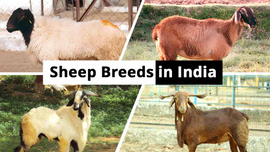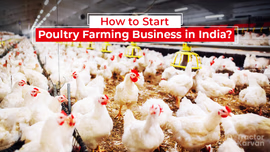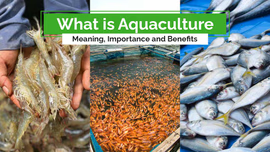How to Start a Duck Farming Business in India?

Duck farming, also called duck rearing or duckery, involves raising ducks for egg production and meat. Commercial duck farming is a relatively new concept in India. It is becoming popular because of the increase in the demand for duck eggs. In this blog, we will discuss the concept of duck farming, its scope, benefits, the process of starting a duck farming business, and the top states with duck farms in India.
Table Of Contents
- What is Duck Farming?
- What is the Scope of Duck Farming Business in India?
- What are the Benefits of Duck Farming in India?
- Which are the Common Duck Breeds in India?
- How to Start a Duck Farming Business in India?
- Top 10 Duck Farming States in India
What is Duck Farming?
Duck farming involves the rearing of ducks for meat and egg production. Ducks hold an important position after chicken farming in India. They are responsible for around 10% of the total poultry population in India and contribute around 6 to 7% of the total egg production in the country. Ducks are primarily concentrated in India's Southern and Eastern states, especially coastal areas with non-descript indigenous stocks, which, however, are considered poor layers. The Indian government formed the Central Duck Breeding Farm under the Ministry of Agriculture in 1981 during the 5th Five-Year Plan in technical collaboration with the Government of the United Kingdom to introduce high-yielding duck varieties for the benefit of the farming community.
What is the Scope of Duck Farming Business in India?
The poultry farm business is one of the fastest-growing agri-businesses in India. As per the data published by Basic Animal Husbandry Statistics (BAHS), the total duck population in India in 2022 was 10.76 million under backyard system. In this population, the total layer desi duck population was 9.60 million, constituting around 87% of the total duck population in the country. The average yield of desi ducks under backyard and commercial farms were 116.87 and 168.19 eggs per year. Under similar conditions, the average egg production of improved ducks was 179.54 and 209.65 eggs per year. As per FAO statistics 2019, the total meat production of ducks in India was 43941 tons and the average carcass yield was 1069 grams. The total number of ducks slaughtered for meat in 2019 was around 33.80 million.
What are the Benefits of Duck Farming in India?
The major benefits of duck farming in India are:
- Accessibility of waterways and ponds. Unlike chicken rearing, duck rearing can be done in a marshy wetland area.
- These watershed regions with ponds and lakes offer earthworms, insects, fungi, algae, snails, small fishes, water weeds, etc., as natural food for the ducks and minimize the feed costs.
- Ducks are considered prolific layers. Even native breeds with high disease resistance lay 160 to 180 eggs in a year.
- Duck eggs are 15 to 20 grams heavier compared to chicken eggs.
- They enrich the soil with their droppings during foraging.
- Ducks are more resistant to diseases compared to chickens.
- They need less care and attention in management.
- Ducks do not need any elaborate houses like chickens.
- Ducks have a longer profitable life from a commercial point of view. They lay eggs well even in the second year of rearing.
- They are ideal for mixed farming like duck-cum-fish farming.
- Ducks act as biological vectors and control many diseases by destroying snails.
Which are the Common Duck Breeds in India?
Duck breeds are mainly divided into egg types and meat types.
- Egg Type: The common egg-type duck breeds reared in India are Khaki Campbell and Indian Runner.
- Meat Type: The common meat-type duck breeds reared in India are Aylesbury, Muscovy, and Pekin.
How to Start a Duck Farming Business in India?
The duck farming business does not require any high-tech equipment or complex systems. The several steps involved in duck farming business, from the selection of breeds to management, are discussed in detail:
Breed Selection
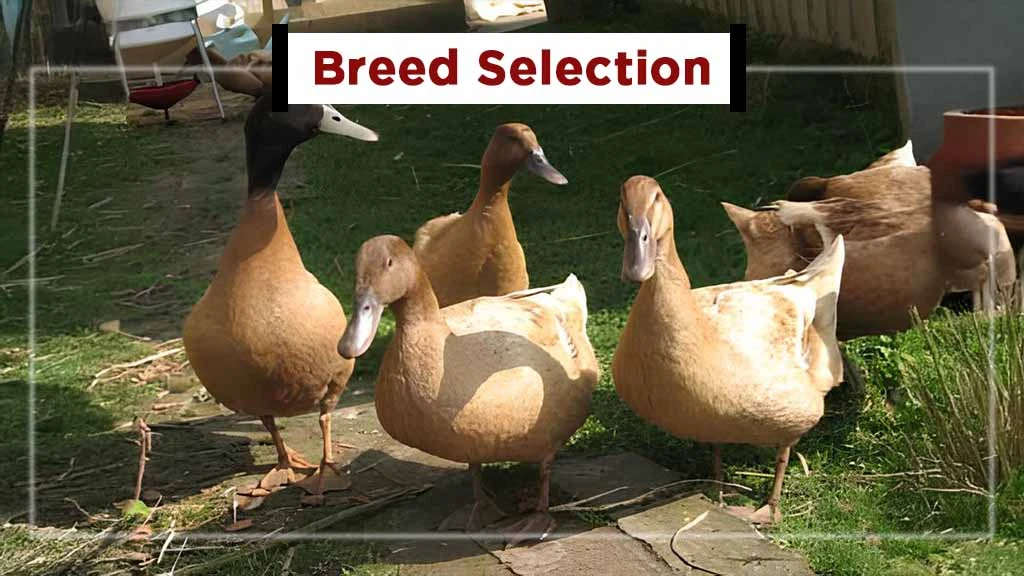
Duck rearing is done for its meat, eggs, and ornamental purposes. So, you need to choose from egg-type breeds or meat-type breeds. The Khaki Campbell and Indian Runner are the most common egg-laying breeds, whereas the Aylesbury, Muscovy, and Pekin are the most common meat-laying breeds.
Housing
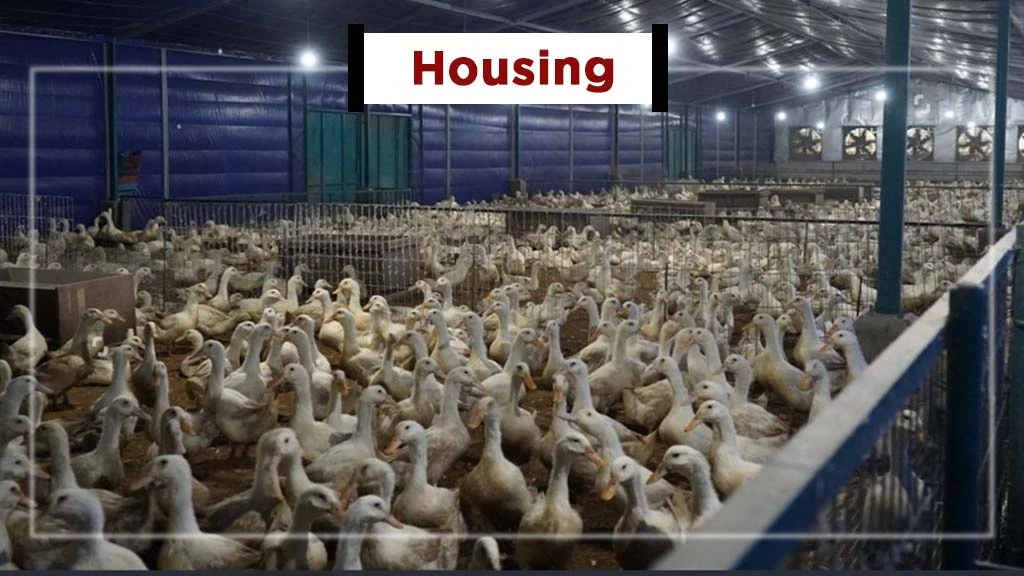
Ducks excrete more water in their faeces, which is why managing them on litter is quite difficult. Therefore, a slatted floor is preferred in the housing so that manure can be washed easily and the floor can be dried out. You can fix welded wires (1.25 cm x 1.25 cm of 8 gauge) on concrete flooring, leaving a gap of 10 cm. After brooding, which takes around 4 weeks, ducks are reared on those welded wires. The housing should be provided where you can also offer a swimming facility. A pond, normally made of concrete, with a dimension of 0.9 m in width and 20 to 30 cm in depth can be provided. The length of the pond depends on the number of birds. You can calculate the house dimensions according to the number and age of birds. You can also estimate the number and size of feeders and drinkers required, depending on their age and numbers. The feeders and drinkers are arranged similarly to chicken.
Brooding
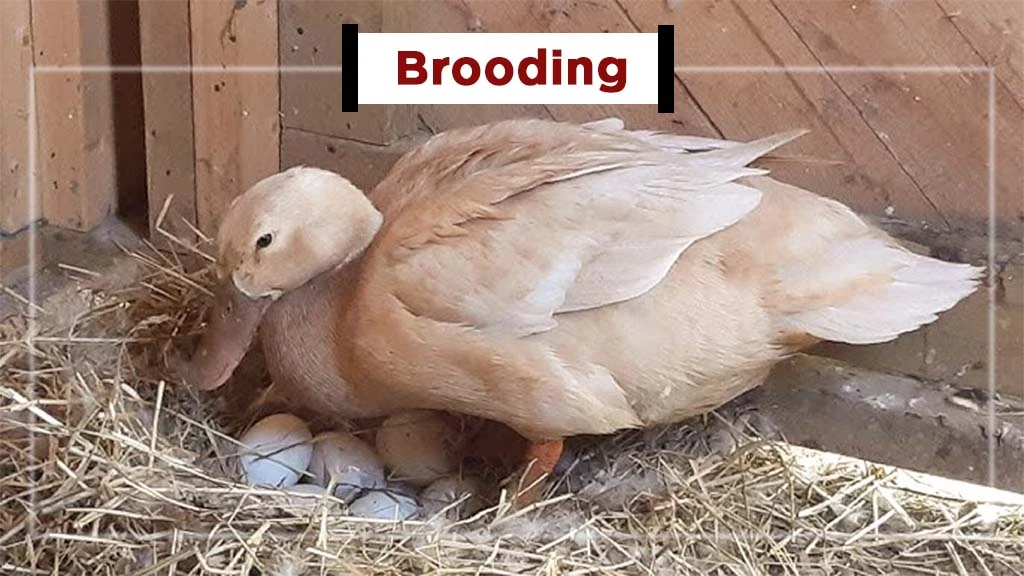
The brooding period of Ducks is different in different breeds. For example, the brooding period for Khaki Campbell ducklings is around 3 to 4 weeks, whereas for meat-type breeds, such as Pekin, the brooding period is 2 to 3 weeks. You need to provide a hover space of 90 to 100 sq cm per duckling under the brooder. You need to maintain a temperature of 29 to 32◦C during the first week of brooding. After that, you need to reduce the temperature by 3◦C weekly until the temperature reaches to 24◦C during the fourth week.
Feeding & Watering
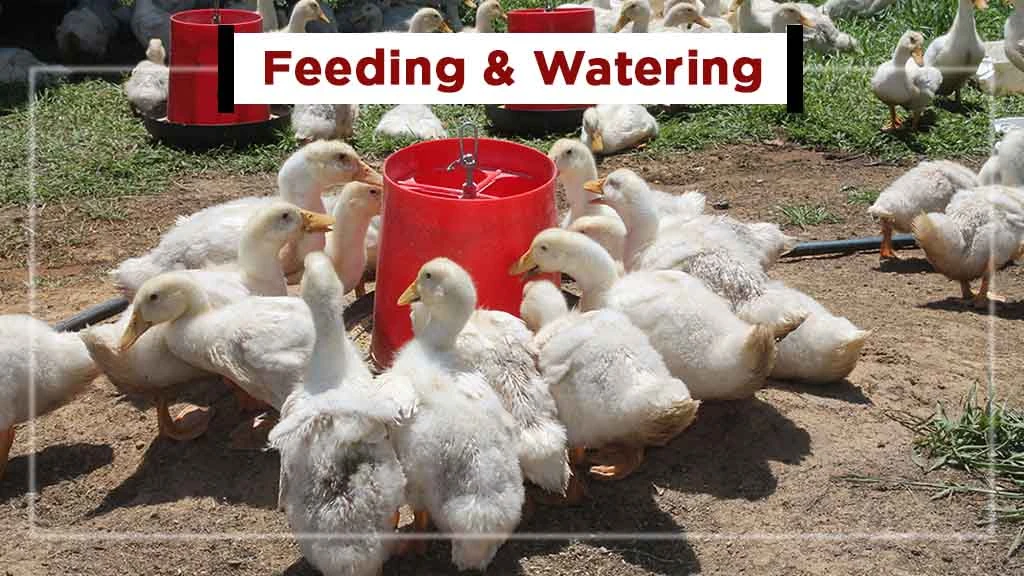
Ducks can be grown on dry mash or a combination of dry and wet mash or pellets. They prefer either wet mash, as they are easy to swallow, or pellets, as they find them easy to eat. Pellet feeding has many advantages, such as saving in feeding amount, saving in labour, minimum wastages, convenience, and improvement in sanitary conditions. Ducks are considered good forage, and the use of ponds or supplementary green feed minimizes the cost of feeding.
Though ducks are fond of water, water for swimming is not important at any stage of duck farming. However, water should be provided in drinkers and should be kept sufficiently deep, allowing immersion of their heads and not themselves. You need to ensure that ducks don't have access to feed in the absence of water.
Rearing
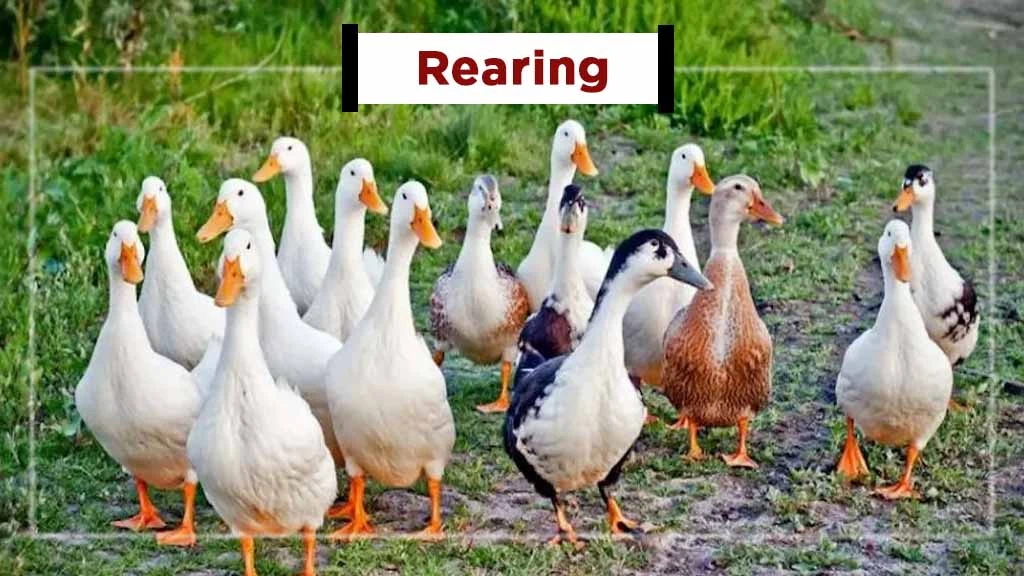
Ducklings can be reared in intensive, semi-intensive, or range systems. The intensive system should have a floor space of 3 sq ft up to 16 weeks of age. In a semi-intensive system, a floor space of 21/2 to 3 sq ft per bird is permitted in the night shelter, and 10 to 15 sq ft is permitted as outside run per bird up to 16 weeks of age. Ducklings are usually permitted to move and run when they reach 3 to 4 weeks of age, depending on the weather conditions.
Management
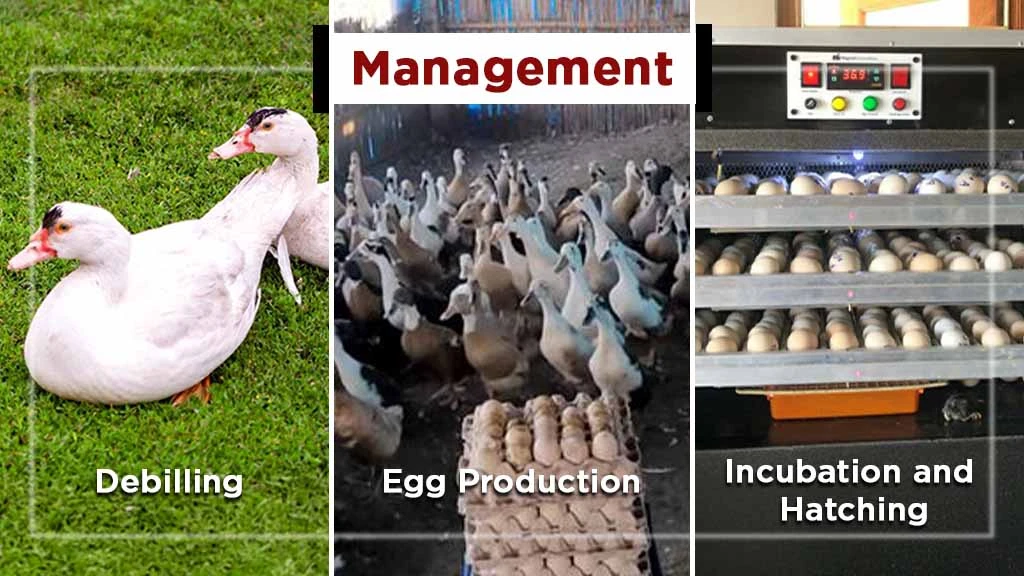
This step consists of three different methods, including debilling, egg production, Incubation and hatching. Let's discuss them briefly:
Debilling
This process is similar to beak-trimming in chickens and starts around 3 weeks of age when adult plumage starts growing. Bill trimming can be a stressful process and can also cause some pain. The lower bill should be left longer than the upper bill after trimming. This process is usually done at a hatchery using an electric beak trimmer.
Egg Production
Ducks can be housed in cages while laying, just like chickens. However, the height of the feed and water arrangement can be reduced suitably. Since ducks do not drink water from nipples, you need to fix the watering channel along the width of the cage in front above the feeding channel with a gap of 10 cm for feeding. The cage dimensions should be the same as that of the chicken. High-rise houses are preferred because of the high moisture content in faeces, or else the concrete flooring can be laid and needs to be washed and drained every day. Ducks should be at least 7 months old when they start laying eggs to ensure the eggs are not of a smaller size. To achieve this, you need to provide a photoperiod of 14 hours per day, three weeks before the expected date of lay. The egg-type duck breeds reach more than 90% production within five weeks. The eggs are usually washed after laying up and then fumigated and stored. To get hatching eggs, it is recommended to have 6 to 8 ducks per drake and the hatching eggs are collected a month after the drakes are permitted with their mates. The nets provided for laying eggs should be clean to ensure the eggs are free from Salmonella, which is quite common in duck eggs. The number of nests should be 30% of the total number of ducks.
Incubation and Hatching
Egg incubation in ducks is similar to chicken. The total incubation period is 28 days and it requires a relative humidity of 75% throughout the period. On 25th day, the eggs are transferred from the setter into the hatcher. If eggs are held for more than a week before setting, they need to be turned daily.
Top 10 Duck Farming States in India
As per the data published by Basic Animal Husbandry Statistics (Government of India), the top 10 duck farming states in India are:
|
State Name |
Production Share (in Percentage) |
|
West Bengal |
37.87 |
|
Assam |
35.95 |
|
Kerala |
5.30 |
|
Manipur |
5.13 |
|
Jharkhand |
5.09 |
|
Tripura |
2.55 |
|
Bihar |
2.05 |
|
Andhra Pradesh |
1.07 |
|
Odisha |
1.05 |
|
Uttar Pradesh |
0.65 |
Frequently Asked Questions On How to Start a Duck Farming Business in India?
1. Is duck farming profitable in India?
Yes, duck farming is profitable in India.
2. How much space is needed for duck farming?
Duck farming is done in intensive, semi-intensive or range systems; each one requires a different floor space.
3. What is the lifespan of a duck in India?
The average lifespan of a duck in India is 8 to 12 years.
4. Can you eat duck eggs?
Yes, duck eggs can be cooked the same way as chicken eggs.


Related Blogs
